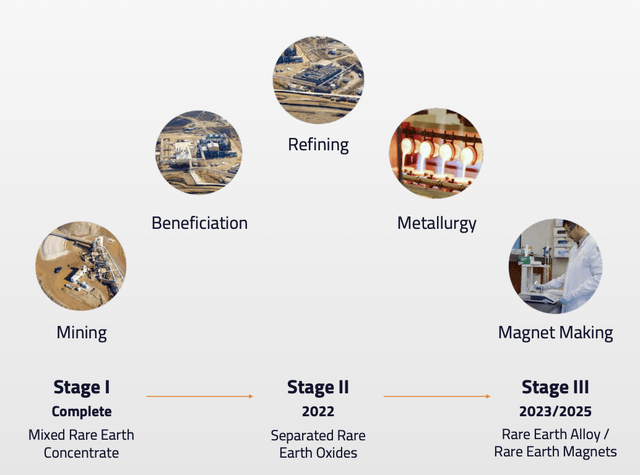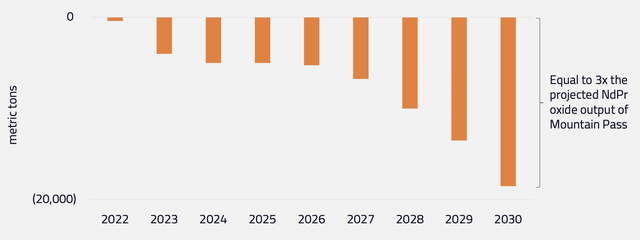Phiwath Jittamas/iStock via Getty Images
MP Materials (NYSE:MP) faces a decade of growth on the back of an accelerated timeline for the adoption of electric vehicles and wind energy. The company owns the Mountain Pass mine, the largest rare earth mining and processing facility in the USA. From here and many other mines like it around the world, rare earth elements are pulled from the earth’s crust and then refined to form the building blocks of modernity. Most relevant for the climate economy are neodymium and praseodymium, or NdPr, which powers the strongest types of rare earth magnets. These enable the conversion of electrical energy into motion via permanent-magnet motors, powering EVs and wind turbines. These now form the pillars of the Inflation Reduction Act whose scope and scale have been understated by even the most optimistic initial commentary.
This comes as MP Materials undergoes a transition from just being a miner of mixed rare earth concentrate to being able to make its own magnets. The construction of its stage 2 optimization project remains on track for this year to allow the company to be able to produce mixed rare earth concentrate.
The move up the economic value chain would not only see the company realize higher levels of profits, but it would also allow them to achieve their goal of helping the US reduce its reliance on China for rare earth elements. The Chinese rare earth monopoly is now unpalatable and is ultimately a risk that creates a single point of failure for the drive to net zero.
Net Zero Has Become Gospel As Initial IRA Impact Understated
Credit Suisse published a research note on the IRA in late October that highlights just how material its fiscal impact will be. The US government stands to spend twice as much as the currently earmarked $370 billion figure because many of the important provisions in the IRA including subsidies for wind and utility-scale battery storage systems are uncapped tax credits.
The government will award credits as long as a project meets the terms. There is no upper ceiling, no budget, and no restrictions. Hence, the IRA will fast become a blank check to the low-emissions industries. Whilst most shareholders are aware of the $370 billion figure initially provided as the fiscal cost over the next decade until 2032, this figure is an understatement.
The IRA’s total spending is likely to be more than $800 billion, 2x more than the frequently cited figure. Further, when you adjust for the crowding-in effects of private capital layering on top of government subsidies, the total allocated capital investments into some of the technologies that will drive NdPr demand to new highs and that constitute its broader total addressable market could top $1.7 trillion over the next decade. The Boston Consulting Group has estimated that the incentives included in the IRA could increase the deployment of zero-carbon energy to up to 80% of electricity production as soon as 2030.
The IRA radically brings forward the timeline for wind power adoption. However, this exacerbates the significant NdPr supply deficit already expected on pre-IRA adoption estimates for both EVs and wind power and would lead to elevated NdPr prices being sticky. US wind is now potentially set to be the cheapest in the world at less than $5 per MWh by 2029 on the back of the IRA.
A Transformational Decade Ahead
The IRA at its core intends to induce faster adoption of renewable energy and EVs and more broadly decouple the US economy from the gyrations of volatile fossil fuel pricing which is currently driving inflation. The energy crisis and controversy around the OPEC+ production quota cut further highlight its long-term importance. The IRA now forms the foundation of MP Materials’ long-term bull case. Its scope and scale represent one of the most pertinent efforts by any other government and against any time in modern American politics to heavily influence the winds of change for its entire energy and passenger transport system.
The company is unique from other mining plays on the climate economy like Albemarle (ALB) and Lithium Americas (LAC) due to its US approach. This brings a geopolitical benefit currently being chased by the US government. The Russian invasion of Ukraine looks set to accelerate the need for a domestic rare earth supply chain as it has exposed a reliance on economic rivals as not a great long-term strategy.
It’s important to note that rare earths also go to a range of other applications including consumer technology, defence and industry. For example, lanthanum is used in imaging applications and cerium is used for LED lighting. This places MP Materials in a position where it is able to ride demand for other technologies that collectively enable trillions of dollars in GDP. The company is one to be considered by clean energy investors.




Be the first to comment